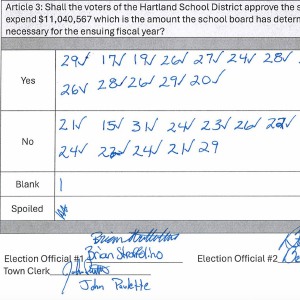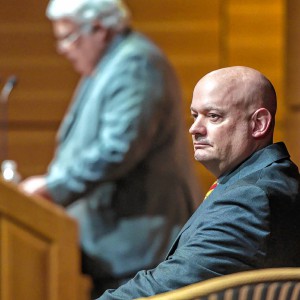Coach buses: Educators get licensed to drive their own sports teams amid hiring shortage
| Published: 02-04-2023 10:45 PM |
HARTFORD — Practice for Hartford Memorial Middle School’s boys soccer teams is supposed to begin at 3:15 p.m.
That means a bus needs to pick up the teams in White River Junction between 3 and 3:05 p.m. to bring them to the fields at Dothan Brook School in Wilder, a roughly seven-minute drive.
“But what happened is in the last several years because of the bus driver shortage, we never knew when that bus was coming,” said Izzy Provoncha, who coaches the A team and is also a social studies teacher at Hartford High School.
Sometimes the bus wouldn’t arrive until 3:30 p.m. By that point, Provoncha and another coach had already set up practice on the high school lawn. When the bus arrived, they had to corral the students and then set up again at Dothan Brook, where they’d get 15 minutes of practice in, if that.
“That was a real source of frustration for me,” said Provoncha, of Tunbridge, who also coaches middle school boys basketball.
In order to get his teams where they need to go, at the time they need to be there, Provoncha decided to become a licensed bus driver this past summer. He got his commercial driver’s license a few days before soccer season started, becoming part of a small — but growing — number of school coaches and employees who are adding bus driver to their resumes.
“I think now in the driver shortage coaches do understand that if they don’t pitch in and actually get their license, their teams might not be able to leave in a timely manner when they want to leave for their games,” said Steve Landon, who is the location manager for Butler’s Bus Service in White River Junction.
When coaches drive their teams, they are paid an hourly rate by Butler’s. Bus drivers start at around $20 an hour.
Article continues after...
Yesterday's Most Read Articles
 Hartland voters successfully petition for school budget revote
Hartland voters successfully petition for school budget revote
 JAG Productions announces closure, citing ‘crisis facing the arts’
JAG Productions announces closure, citing ‘crisis facing the arts’
 Hanover’s Perreard may soon capture the attention of collegiate coaches in two athletic pursuits
Hanover’s Perreard may soon capture the attention of collegiate coaches in two athletic pursuits
“When they drive a bus to a game, I’m paying them the whole time,” said Landon, who coaches Woodstock Union High School’s boys basketball team (but doesn’t drive the bus for them).
Of the roughly 180 bus drivers employed by Butler’s — which provides transportation to 10 Upper Valley school districts — about 15 to 20 are school employees, Landon said. While that is admittedly not a high percentage, Landon has noticed more interest from educators who want to learn to drive buses. Butler’s pays for their certification process.
There has been a driver shortage for a number of years, but it worsened during the COVID-19 pandemic. Older bus drivers started to step back from their roles.
“Many of those folks decided that they didn’t want to be around a lot of people, which is understandable,” Landon said. “We’re still trying to navigate our way through this extreme driver shortage.”
He has noticed a slight demographic change: More people in their 30s and 40s are choosing to get licensed. Landon has also recruited retired teachers and educators.
“The standard bus routes are really what we need to focus on, because that’s what our customers and contracts call for,” Landon said.
Due to the bus driver shortage, routes throughout area districts have been changed based on the availability of drivers. If a driver has to double up and do two morning routes, for example, some children will be picked up much earlier than usual.
Morning and afternoon commuting routes take priority over games and practices. While athletic directors work with Butler’s to set schedules in advance, if a bus driver calls out sick, other employees must be moved around to cover shifts and finding a driver to fill in can be difficult. Athletic directors work together to adjust games to fit driver availability.
“It’s been an athletic director’s nightmare,” said Stephen Stebbins, who is athletic director for the Mascoma Valley Regional School District and also coaches soccer and wrestling. “A lot of rescheduling, a lot of changing of times, that sort of thing.”
Stebbins got his CDL in September 2021, just after the start of soccer season. He took classes over the summer, which include school-bus-specific certifications along with standard CDL requirements, and started driving his team that fall. Mascoma has four educators who also work as bus drivers, Superintendent Amanda Isabelle wrote in an email.
“I just thought it’d be a great way to ensure at least my teams are going to get where they’re going on time every day,” Stebbins said, adding that while none of Mascoma’s games have been outright canceled due to the driver shortage, some have had to be rescheduled. “In some ways it was a major blessing this fall, because there were close to eight games that I drove that I wasn’t really planning on driving, where those games probably wouldn’t have happened if I wasn’t licensed.”
Sometimes student-athletes are brought to games earlier than they need to be.
“It’s not good for the kids because they’re getting out of school an hour early for a game they wouldn’t have to get to an hour early for,” Stebbins said. “We’ve had times where we go somewhere and sit around for an hour.”
That’s something every athletic director has had to deal with, including Heidi Wright, activities and athletic director at Oxbow High School in Bradford, Vt. While no games have been outright canceled due to the driver shortage, some have had to be rescheduled.
“I’ve been fortunate enough that I get everyone where they need to go; it just hasn’t been in the time frame that I prefer,” Wright said.
Sometimes, student-athletes are dropped off late, which means they might have a shorter amount of time to use the restroom, stretch and warm up.
“Sometimes that seems a little bit rushed,” Wright said. On the flip side, if student-athletes arrive too early, that’s more time to fill with activities.
“It’s definitely a bigger struggle in the fall and the spring because of the time that the games start,” she said.
Outdoor spring and fall sports require daylight, so the times cannot be adjusted as easily. In winter sports, which take place indoors, are a little more flexible.
Different teams can share the same bus as long as there’s room for all students, coaches and equipment, Wright said. They also have to be going in the same direction. In some cases, Oxbow will share a bus with neighboring Blue Mountain Union School in Wells River for a cross country meet.
“It becomes that creative thinking,” Wright said.
Weather delays and games being rescheduled can make booking drivers more complicated. That’s another benefit of coaches getting their bus driver’s license: They have more flexibility.
When there’s coach on staff is also a bus driver, Wright said, “you don’t have to worry about that program.”
Chuck Simmons is one of those coaches at Oxbow. He helms middle school soccer, JV boys basketball and varsity softball and is the assistant boys basketball coach. He got his bus driver’s license and became a contract employee for Butler’s around three years ago after being inspired by another coach. Simmons, who works full time for the Vermont Department of Transportation in White River Junction, will often drive an after-school route for the Hartford School District before heading up to Bradford to coach.
“I strongly advise if you’re ever a coach in a high school position to get your CDL because of the lack of drivers out there,” Simmons said. “One, it’s a benefit for the school to be able to rely on you to be able to take your team. Another is that you get paid.”
While no one coaches school sports for the money, it is safe to say that the hourly rate for bus drivers is more than that for coaches who are paid a set salary for the season. The extra income is added upside.
Vermont requires school bus drivers to have a CDL. Simmons already had one through his job at VTrans, so he was only required to take a bus driving course and pass a licensing test. Stebbins, meanwhile, did not have much experience driving larger vehicles, but had pulled trailers on trucks and after the first couple days of training was comfortable with the bus. Provoncha, the Hartford coach, had operated heavy equipment while he worked on a dairy farm, and that background made him feel comfortable with a school bus. It took him about three weeks to go through the CDL and bus driver classes before becoming licensed.
“It’s pretty rigorous,” Provoncha said. But it’s also been well worth it. “The convenience is unreal.”
Coaches who drive buses never drive students alone — they’re accompanied on the bus by other coaches or educators.
“I have to take my coaching hat off when I’m driving,” Simmons said.
In addition to helping the district, it also provides students — and to a degree, their parents — with more stability.
“Kids, especially middle schoolers, need structure and continuity,” Provoncha said. “My only regret is not doing it before. I should have done it years ago because it’s super convenient and it’s fun.”
Liz Sauchelli can be reached at esauchelli@vnews.com or 603-727-3221.

 At Dartmouth, hundreds protest ongoing war in Gaza and express support for academic freedom
At Dartmouth, hundreds protest ongoing war in Gaza and express support for academic freedom Over Easy: ‘A breakfast without a newspaper is a horse without a saddle’
Over Easy: ‘A breakfast without a newspaper is a horse without a saddle’ Lawsuit accuses Norwich University, former president of creating hostile environment, sex-based discrimination
Lawsuit accuses Norwich University, former president of creating hostile environment, sex-based discrimination
